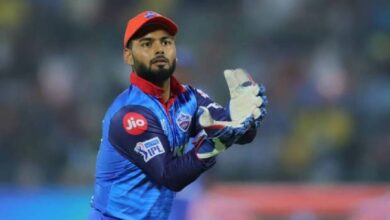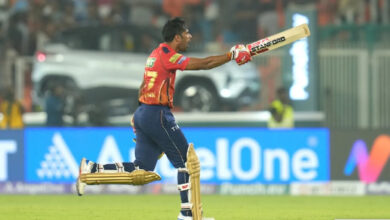Border Gavaskar Trophy: Another shocker; after Hardik, now Steve Smith slams Indian pitches

The Border-Gavaskar Trophy series is more than a week away, but pitches have already started dominating discussions, and in both countries.
While the visiting Aussies have done away with any practice games before the first Test starting on February 9, believing that pitches provided for such matches rarely mirror what is dished out for the main event, even the hosts have been less than pleased with the surfaces prepared for international encounters of late.
The Australian players not part of the Big Bash League had a camp in Sydney on pitches, especially scuffed up in anticipation of what is expected in India, Hardik Pandya termed as “shocker” tracks provided for the first two T20Is against New Zealand, prompting the sacking of Lucknow curator. It is ironic that the pitches were criticised for taking too much spin, something that the Australians are also wary of.
Before Pat Cummins and his squad left for India, they practised on tailor-made pitches at the North Sydney Oval for a few days. The centre square, according to pictures circulated in Australian media, looked dark and scuffed up, cracks bursting from good-length areas of spinners, revealing the black sand underneath. This was where Australia prepared for the trial spin that awaits them in the four-Test series in India.
It is customary for the build-up to a marquee home series in India to begin with pitch-horoscope, layered speculations, presumptions and intrigue. Usually, to prepare for the impending tribulations, the visitors would eagerly strap up for warm-up games so that they could get a hang of the conditions, test themselves in unfamiliar climes and shore up their confidence.
But Australia have learned their lessons and have concluded that warm-ups are purposeless. “The last time we went, I’m pretty sure we got served up a green-top (to practise on) and it was sort of irrelevant,” Steve Smith said at the pre-departure press conference. “We’re better off having our own nets and getting spinners in and bowling as much as they can.”
The term “green-top” was an exaggeration. Rather, it was a shirt-front, on which Smith and Shaun Marsh reeled off centuries and Shreyas Iyer smacked a near run-a-ball double hundred. After injecting a false sense of confidence, they were thrust onto two devilishly turning and bouncing wickets in Pune and Bangalore.
It has been a recurring pattern around the world — visitors would often be offered surfaces that they are least likely to encounter in Test matches. Often they would play on surfaces with exactly the opposite nature. For instance, the last time India toured England, they were gift-wrapped a batting beauty, offering negligible swing.
So Australia have stopped playing tour games, they did not on their trips to Pakan and Sri Lanka. Head coach Andrew McDonald elaborated further: “Often there’s no real connection between that practice game into the first Test match. We feel as though we can control the surfaces here. [We] get a bit more control in Bangalore (where they will be based before the Test series starts) to replicate what we’re going to come up against, and then we go into Nagpur fresh and hopefully it pays dividends at the back end.”
‘Shockers’
Had they watched the T20 series between India and New Zealand, they would have been utterly terrified at the wickets in Ranchi and Lucknow. If the strips for T20Is turned, jumped and bounced, what awaits them in the Tests!
But the paradox cannot be escaped from. After dishing out the calamitous turner in Lucknow, the local association sacked the curator. Had he prepared this pitch for a Test, the captain or the coach could have tipped him a decent sum. Pandya, who is leading India in the T20I series, called both decks “shockers”.
“To be honest, it was a shocker of a wicket. In fact, both the games we have played on so far. I don’t mind difficult wickets. I am all up for that, but these two wickets are not made for T20,” he said after the match.
One can’t imagine Rohit Sharma making statements of this nature in a Test match. Or head coach Rahul Dravid, who has not openly called for turners yet. Even during his days as India’s captain, he was not supposedly the one to order curators for a specific type of wicket. But with a spot in the World Test Championship final at stake, India could rely on turners to see them through.
In Dravid’s tenure, India have not resorted to violent turners. The sample size is small — under Dravid, India has played just four Tests at home, two apiece against Sri Lanka and New Zealand, winning three and drawing one. Though all four tracks did ass spinners at different stages, none of them were unplayably terrible. The Australia series thus would be the biggest series yet under him, and probably would show a clearer picture on how he perceives turners when push comes to shove.
The turners in T20s and Tests need some contextualisation. Whereas in Tests, it’s an element subcontinent teams use to maximise advantage, just as England and New Zealand resort to swing, Australia to bounce and South Africa to both swing and bounce, in T20Is, turners are un-permissible as it robs a proper contest with bat and ball. It would be the same if a T20 game is played in swinging or seaming conditions. So, fundamentally, turners are a preserve of the five-day game, one that India might scowl at in T20s or ODIs but greet with folded arms in Tests.
To dig into recent hory, whenever a big prize is at stake, India tend to dish out turners. Of all hues — ones with spin and bounce, those with spin and invariable bounce, low and slow types, sharp and square-turning ones, snake-pits and dust bowls, bunsen burners and akhadas. When England toured last time, India needed to win the series to make the WTC final. Duly, turners were rolled out in Ahmedabad and Chennai.
So, Smith and Co. would not need a soothsayer to foretell the nature of the pitches or a spy to nick classified information from the curator’s cave in the stadium. They would hope that their experience, practice on the scuffed-up North Sydney Oval, and the ground staff at Alur where they would practice for four days, would help them slay the spin-ghosts.







